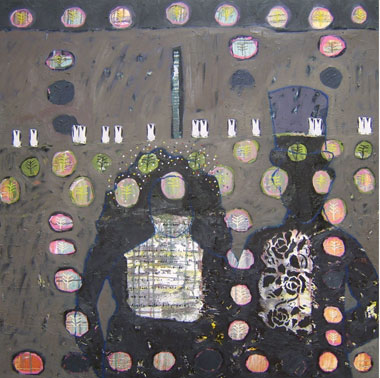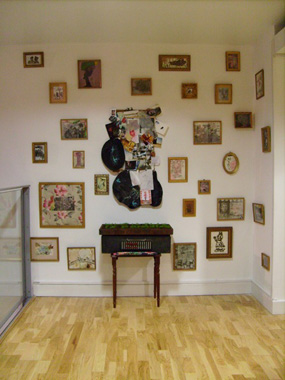 |
Thomas Brezing, Without rhyme or reason I, 2007, oil on canvas, 90 x 90 cm; courtesy The Lab. |
German-born artist Thomas Brezing’s one man show at The Lab on Foley Street, Seven miles above the earth, consists of twelve paintings and two installation works spanning the mezzanine floor, the hallway and the staircase. Walking through the show, one might be reminded of visiting the house of an elderly relative – the type of house that bursts with chintzy roses, family photographs and images from children’s books. Muted, faded colours in the paintings and the mock ‘living room’ installations all add up to a ‘granny’s attic’ aesthetic in this show which draws the viewer in. However, there is a darker side to this nostalgic façade. Disney characters – mostly Snow White and the seven dwarves – are deliberately sloppily executed, like a child’s rendition, and the flowers and roses which populate the works are wilted, isolated and lethargic. Combined with these elements are the ‘photographs’ [ 1 ] of Hitler and other Nazis and images such as the eagle atop a swastika, the symbol of the National Socialist German Workers Party.
Fairy-tale imagery is dominant in the works, as an indicator of innocence spoiled by reality. Like Gottfried Helnwein, in his portrayals of Mickey Mouse and Donald Duck, Brezing causes the viewer to remember back to childhood and recall and question the truth of the emotions connected with those images. A painting with the three little piggies, He left us full of father, is placed beside a young boy holding a hand-mirror with the reflection of a pig in I was safe in her shadow . In Thank you for having us, a bed of roses simultaneously supports a multiplying number of Snow Whites, dwarves, and woodsmen’s cottages, whilst at the bottom of the canvas, concealed behind the roses, are several pallid, sleeping babies. Perhaps Brezing is assuaging the guilt he feels at his innocent childhood, ignorant to the horrible events which took place in his homeland, at the hands of a previous generation. Lucy Cotter has said that “the paintings itch the sore spots, brood on areas of confusion, look for comfort and confrontation, and attempt to do the impossible – offer an apology.” [ 2 ]
 |
| Seven miles above the earth, Installation shot, including I was safe in her shadow, He left us full of father, and Thank you for having us; courtesy The Lab. |
Brezing was born in 1969 in a Germany finally emerging from the wounds of World Wars I and II. He only learned of the wars in the classroom with his fellow students; “Some of my classmates were in denial and brushed it off, but others – myself included – felt a huge sense of burden.” [ 3 ] Brezing retains that burden and transfers it to his art. Seven miles above the earth is, for Brezing, completely tied up in the relationship he has to the grandparents he never met. His grandparents were married in 1923 but were both dead by the time Brezing was born. Having recently found a photograph of their wedding, Brezing has created an entire body of work in connection to this one image. The outline of their bodies from that photograph is a recurring motif in the exhibition, as are references both to the aesthetic of the ‘granny’s attic’ and to the relationship between young child and grandparent.
 |
Seven miles above the earth, Installation shot including The loneliness of being German, 2007, mixed media; courtesy The Lab |
The loneliness of being German, the installation at the end of the mezzanine, is the mock set of a living room. A fireguard is at the centre, two brass fire-iron rests are on the floor beside vases of flowers, the wall is painted a warm fawn colour and littered with photographs and paintings. However, the fireguard is old and tattered, the flowers are wilted and dead and the photos on the wall are of, among others, Hitler and other Nazi-party members. In an interview with Lucy Cotter, Brezing describes his fear when, for a time, it was possible that his grandfather had been a Nazi officer. “In a book about the history of my hometown, a former Nazi stronghold, my surname was mentioned in connection with a Nazi official. I thought this could have been my Grandfather since Brezing is a rare name. It turned out that it wasn’t him but it was a close call.”[ 4 ]
 |
Thomas Brezing, Perished futures – found pasts, 2007, oil on canvas, 90 x 90 cm; courtesy the artist. |
Roses abound throughout the show, in a reference both to the vintage and chintzy aesthetic and to the ‘White Roses’ Nazi-resistance movement. Brezing aptly acknowledges the fact that we cannot know whether we would have resisted the Nazis or joined the ranks; “It is easy to say in retrospect where one would have liked to see oneself, but you will never know for certain.” [ 5 ] In Perished futures – found pasts – a painting which utilises the outline of the grandparents as a backdrop for abstract patterns – there is a confession-cum-apology inscribed on the chest of the grandmother figure.
 |
Thomas Brezing, The end of the war is mine, mixed media, approx. 240 x 270cm; courtesy the artist. |
The end of the war is mine is the second installation work in the show. It is similar in set up to The loneliness of being German; however, one gets the sense that this ‘living room’ belongs to a much younger person. In contrast to the warm background wall colour in The loneliness of being German, the wall here has been left a stark white. Similar images are framed on the walls, Hitler pictured alone and with some officers, the photo of the 1923 wedding; but there are more recent images also, leading to the conclusion that whilst The loneliness of being German may have been the living space of the artist’s grandparents, The end of the war is mine is a mock set-up of the artist’s own living space. A pinboard in the centre of the wall contains contemporary photographs of what we imagine are family members and friends; there are drawings and paper dolls and a tracing-paper sketch of the photo of Hitler. A barbeque supports a container of dirt where –– with a nod to Hans Haacke’s Der Bevölkerung in the Reichstag – the question ‘what if this is paradise?’ has been grown in grass. “The Germans would love if a lot of grass grew over their past, but there are people in every generation, who, like cows, eat away the grass until the horrible truth becomes visible again. I am such a cow.” [ 6 ]
 |
Thomas Brezing, We do not love as flowers love, 2007, oil on canvas, 200 x 450 cm; courtesy the artist. |
We do not love as flowers love reveals the artist’s own insecurities about dealing with a subject matter, 60 years old. This painting is an assemblage of previous paintings, including As they seperated the healthy from the sick and The ongoing funeral, two works which reflect the landscape paintings of Anselm Kiefer. Large letters, covered in white roses: ‘THE WORLD IS OVER TERE’ extends across the rows of uniform people, faced towards the giant Nazi symbol, like a scene from Leni Riefenstahl’s Triump of the will . The masses are ignored and relegated to the background in favour of the characters which voice some of the artist’s insecure thoughts. Little creatures and figures scramble all over the letters with speech bubbles protruding from their mouths; “yeah, dude, all that war crap, doesn’t he know the war is over,” “are you sure this is the right spelling?” More speech bubbles reveal that the imagined characters are acting behind the artist’s back, or that this painting is nothing more than a mess. The swaztika in the Nazi symbol has been replaced here by a disc of red roses – another atonement for Brezing’s guilt.
Thomas Brezing’s works in Seven miles above the earth set nostalgia against reality. They reflect on the nature of memory and the unsettling recognition that memories can give a false sense of reality They shake up the notion of ‘the good old days’ and the desire to view the past and one’s predecessors as fundamentally ‘good’ or better than the present, or the living. The works are confessions of short-lived innocence, and long-lived fears. Brezing has laid bare that schoolchild burden and bravely showcased it in his art. He has become “answerable through and through.” [ 7 ]
Hollie Kearns is an art historian and critic.
1 These ‘photographs’ are in fact drawings on tracing paper, but with a very photographic feel.
2 Lucy Cotter, ‘Introduction’, Thomas Brezing, Nation Without Friends, 2007
3 Thomas Brezing in conversation with Lucy Cotter, ‘Interview with Thomas Brezing by Lucy Cotter (2006-7)’, Thomas Brezing, Nation Without Friends, 2007
4 Ibid.
5 Ibid.
6 Ibid.
7 Michael Bakhtin, ‘ Art and Answerability’ (1919), quoted by Lucy Cotter, ‘Introduction’, Thomas Brezing, Nation without Friends, 2007